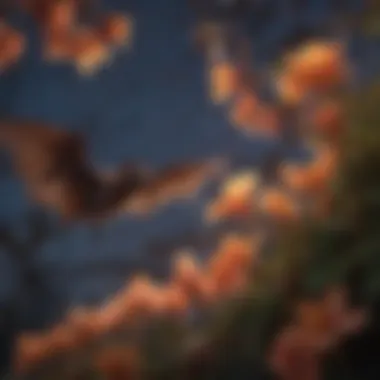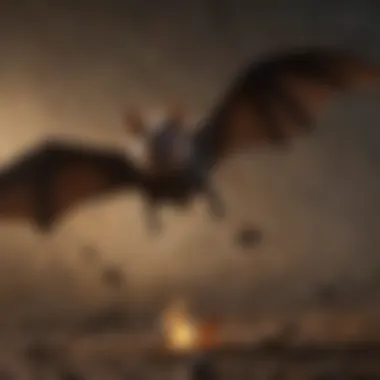The Vital Role of Bats in Ecosystem Preservation and Sustainability


Overview of the Topic
Bat populations are vital to ecosystems, playing a crucial role in maintaining balance and sustainability. These enigmatic creatures offer invaluable services that benefit biodiversity and environmental health. From pollination of plants to natural pest control, bats play a significant part in various ecological processes, making them indispensable in the intricate web of life.
Current Status and Challenges
Despite their critical importance, bat populations face numerous challenges and threats in today's world. Factors such as habitat loss, pesticide use, and climate change have led to a decline in bat numbers globally. This decline poses a serious risk to ecosystem stability and biodiversity, highlighting the urgent need for conservation efforts to protect these invaluable creatures.
Sustainable Solutions
To address the challenges faced by bat populations, implementing sustainable practices is crucial. Conservation efforts such as protecting natural habitats, reducing pesticide usage, and raising awareness about the importance of bats are essential steps in ensuring their survival. By promoting sustainable resource management and adopting bat-friendly practices, we can contribute to the conservation of these vital species.
Impact and Importance
The impact of bats on ecosystems, communities, and future generations cannot be overstated. Bats play a key role in pollinating plants, including many fruit-bearing species essential for human consumption. Additionally, their pest control services help maintain ecological balance and reduce the need for harmful pesticides. Conservation of bat populations is not only important for biodiversity but also for ensuring a sustainable future for all living beings on our planet.
Introduction
In the intricate web of ecosystems, bats emerge as unsung heroes, playing a pivotal role in maintaining balance and biodiversity. Their often underappreciated significance extends across various ecological functions, from pollination to pest control, contributing to the sustainability of natural environments. As we delve into the world of bats, we uncover a realm where these nocturnal creatures wield immense influence, vital for the harmony of ecosystems.
Understanding the Importance of Bats
Bats as Key Pollinators
Within the realm of pollination, bats serve as key players, facilitating the reproduction of numerous plant species often overlooked by other pollinators. Their nocturnal habits perfectly align with many night-blooming flowers, making them exclusive pollinators during these crucial hours. This unique characteristic allows bats to pollinate various plants that other diurnal pollinators cannot access, enriching the diversity of plant life.
- Bats excel at pollinating night-blooming flowers, ensuring the continuation of plant species that rely on nocturnal pollination.
- The exclusive partnership between bats and specific plant species highlights their irreplaceable role in ecosystem functioning.


Bats as Pest Control Agents
In the realm of pest control, bats emerge as natural predators, curbing insect populations with remarkable efficiency. Their voracious appetite for insects, including agricultural pests, contributes to the sustainable management of pest populations without the need for harmful chemicals. This natural pest control service provided by bats helps maintain ecological balance while reducing the reliance on synthetic pesticides.
- Bats' consumption of vast quantities of insects, including crop pests, aids in natural pest management and agricultural sustainability.
- The reliance on bats for pest control diminishes the environmental impact of chemical insecticides, promoting a more ecologically friendly approach.
Bats' Role in Seed Dispersal
The role of bats in seed dispersal crucially impacts plant regeneration and the maintenance of diverse ecosystems. By consuming fruit and dispersing seeds across wide areas through their droppings, bats contribute to the regeneration of forests and the enrichment of plant diversity. This unique seed dispersal mechanism carried out by bats plays a fundamental role in sustaining the health and resilience of various plant communities.
- Bats' foraging habits and seed dispersal contribute significantly to the growth and regeneration of forests and plant biodiversity.
- Their effective seed dispersal enhances ecosystem resilience and promotes the establishment of diverse plant species in various habitats.
Significance of Bat Conservation
Impact of Habitat Destruction
One of the primary threats to bat populations is the destruction and fragmentation of their habitats due to human activities. Habitat loss directly impacts the availability of roosting sites and foraging areas for bats, leading to population declines and species endangerment. The continuous degradation of bat habitats underscores the urgency of conservation efforts to protect these critical ecosystems.
- The detrimental effects of habitat destruction on bat populations highlight the urgency of conservation actions to safeguard crucial habitats.
- Addressing habitat loss is paramount to ensuring the continued existence of diverse bat species and the preservation of their ecological contributions.
Threats to Bat Populations
Various threats, including climate change, pollution, and disease, pose significant challenges to bat populations worldwide. Climate change alters the distribution of prey species, affecting bats' foraging patterns and survival. Pollution further exacerbates the health risks faced by bats, while diseases like White-Nose Syndrome have decimated bat populations in certain regions. Understanding and mitigating these threats are crucial for the long-term survival of bats.
- Climate change, pollution, and diseases like White-Nose Syndrome pose significant threats to bat populations, requiring urgent conservation actions.
- Mitigating these threats through targeted conservation efforts is essential to ensure the resilience and survival of bat species in the face of environmental challenges.
Efforts for Bat Conservation
Amidst these challenges, global conservation initiatives have emerged to protect bat species and their habitats. International collaborations, research endeavors, and community involvement play vital roles in raising awareness, conducting conservation projects, and advocating for policy changes to support bat conservation. These combined efforts aim to mitigate threats, restore habitats, and secure a sustainable future for bats and the ecosystems they inhabit.


- Global conservation initiatives leverage international partnerships and community participation to advance bat conservation efforts worldwide.
- By fostering collaboration and engaging diverse stakeholders, conservation initiatives strive to preserve bat populations, restore habitats, and promote environmental sustainability.
Ecological Contributions of Bats
When delving into the ecological contributions of bats within the ecosystem, their significance cannot be overstated. Bats play a pivotal role as pollinators, helping to sustain the balance of various plant species. Their unique ability to pollinate plants contributes to the reproduction and growth of different vegetation types, showcasing their value in maintaining plant biodiversity. Additionally, bats serve as key agents in pest control by preying on insects, thus assisting in regulating insect populations. This dual role of bats as pollinators and pest controllers highlights their essential role in ecological processes and ecosystem health. Understanding and appreciating these ecological contributions is crucial for promoting environmental stability and biodiversity conservation.
Bats as Pollinators
Types of Plants Pollinated by Bats
The types of plants pollinated by bats include a diverse array of species ranging from flowering cacti to fruit-bearing trees. Bats are particularly attracted to night-blooming plants with large, fragrant flowers, such as agave and mango trees. These plants have co-evolved with bats, developing key adaptations to attract these mammalian pollinators. The unique morphology of bat-pollinated flowers, such as long tubular shapes and copious amounts of nectar, enhances the efficiency of bat pollination. Despite being overshadowed by bees and other insects, bats' role in pollinating specific plant species contributes significantly to habitat diversity and plant reproduction.
Comparison with Other Pollinators
In comparison to other pollinators like bees and butterflies, bats offer distinct advantages in pollination. Bats are efficient long-distance pollinators, capable of covering significant distances in search of food sources. Unlike diurnal pollinators, bats predominantly operate at night, complementing the pollination activities of daytime insects. This nighttime activity enhances overall plant reproductive success by extending the pollination period into the evening. Furthermore, bats are known to pollinate certain night-blooming plants that other pollinators might neglect. These unique characteristics of bat pollination enrich ecological interactions and contribute to the resilience of plant communities.
Pest Control Role of Bats
Impact on Insect Populations
The impact of bats on insect populations is a crucial aspect of their role in ecosystem dynamics. Bats help regulate insect populations by consuming vast quantities of insects during their nocturnal foraging. This consumption not only reduces pest damage to crops and forests but also aids in maintaining the balance of insect populations in various habitats. By targeting insects such as moths, beetles, and mosquitoes, bats play a vital role in natural pest control, reducing the need for chemical insecticides. Their preference for specific insect species helps control particular pests that affect agricultural and natural ecosystems.
Natural Pest Control Methods
Bats employ natural pest control methods to manage insect populations effectively. Unlike conventional pest control measures that rely on chemicals, bats offer a sustainable and environmentally friendly approach to pest management. By preying on insects as part of their diet, bats help control pest populations without causing harm to the ecosystem. This natural pest control system benefits both the environment and human activities, promoting agroecological balance and reducing reliance on synthetic pesticides. Encouraging the presence of bats in agricultural landscapes can lead to improved pest control outcomes and long-term sustainability.
Seed Dispersal by Bats


Ecological Significance
Seed dispersal by bats holds immense ecological significance in maintaining plant diversity and ecosystem resilience. Bats play a vital role in dispersing seeds of various plant species across diverse habitats, contributing to the regeneration of plant communities. The seeds dispersed by bats often have specific adaptations for dispersal by these flying mammals, such as small sizes or attached structures for easy transport. This process of seed dispersal by bats facilitates the colonization of new areas by plants and enhances genetic diversity within plant populations. The ecological impact of bat-mediated seed dispersal extends to forest regeneration, habitat restoration, and the overall health of ecosystems.
Relationship with Plant Diversity
The relationship between bats and plant diversity underscores their mutualistic interactions and the interconnectedness of species within ecosystems. Bats prefer fruit from a variety of plant species, ranging from small shrubs to large trees, reflecting their role in supporting plant diversity. By dispersing seeds over wide areas, bats contribute to the spatial distribution of plant species and the formation of diverse plant communities. This close association between bats and plant diversity not only benefits vegetation but also sustains the wildlife that relies on diverse plant resources. Understanding the relationship between bat-mediated seed dispersal and plant diversity sheds light on the intricate web of ecological connections that shape ecosystem dynamics.
Challenges and Conservation Efforts
In exploring the intricate web of interactions within the ecosystem, it becomes evident that addressing the challenges faced by bats and implementing conservation efforts are crucial endeavors. The symbiotic relationship between bats and their surrounding environment highlights the delicate balance that must be maintained to secure ecological stability. Understanding the significance of conserving bat populations transcends mere preservation; it embodies a commitment to safeguarding biodiversity and maintaining the vitality of our ecosystem. Emphasizing the interconnectedness of all living organisms, including bats, underscores the urgency of taking proactive conservation measures.
Habitat Loss and Fragmentation
- Impact on Bat Habitats: The impact of habitat loss and fragmentation on bat habitats manifests in the disruption of their roosting sites, foraging areas, and migration patterns. As human activities encroach upon natural landscapes, the available habitats for bats diminish, leading to population declines and reduced genetic diversity among bat species. The loss of specific roosting sites, such as caves and trees, further exacerbates the challenges faced by bats in finding suitable shelter and breeding grounds. [ Impact on Bat Habitats] Despite bats’ ability to adapt to diverse environments, the rapid destruction and fragmentation of their habitats pose a significant threat to their survival. This depletion of suitable habitats not only results in localized extinction of bat colonies but also hinders their abilities to maintain healthy populations. The loss of critical roosting sites can disrupt established social structures within bat communities, impacting their social behaviors and reproductive success.
- Correlation with Population Decline: The correlation between habitat loss and fragmentation and the decline in bat populations is a pertinent issue necessitating immediate attention. The interdependency between bats and their habitats underscores the cascading effects of population declines not just on bat species but also on the broader ecosystem. As bat populations dwindle due to habitat degradation, the ecological services they provide, such as pest control and pollination, diminish, creating ripple effects throughout the ecosystem. [ Correlation with Population Decline] The correlation between habitat loss and population decline elucidates the critical need to address conservation efforts to mitigate the adverse impacts on bat populations. Establishing protected areas and implementing habitat restoration initiatives are vital steps towards reversing the negative trajectory of bat populations. By recognizing the intricate relationship between habitat quality and bat abundance, conservation strategies can be tailored to promote sustainable coexistence between bats and human activities.
White-Nose Syndrome
- Effects on Bat Health: White-nose syndrome poses a severe threat to bat populations, causing widespread mortality and physiological distress among affected individuals. The fungal disease disrupts bats’ hibernation patterns, leading to increased energy expenditure and eventual starvation. The effects of white-nose syndrome extend beyond individual health to alter the dynamics of entire bat colonies, resulting in population declines and imbalanced ecosystems. [ Effects on Bat Health] The devastating effects of white-nose syndrome underscore the vulnerability of bat populations to emerging diseases and highlight the interconnectedness of ecosystem health. Bats serve as bioindicators of environmental stressors, with the spread of white-nose syndrome serving as a poignant reminder of the intricate balance within natural systems. Understanding the mechanisms of disease transmission and mitigating its impacts are essential components of effective bat conservation efforts.
- Management Strategies: Developing comprehensive management strategies to combat white-nose syndrome is imperative for preventing further population declines and safeguarding bat populations. Interventions such as promoting disease surveillance, enhancing habitat suitability for bats, and implementing biosecurity measures are essential for mitigating the impact of white-nose syndrome. By integrating research-based strategies with community engagement, conservationists can optimize their efforts in minimizing the spread of the disease and protecting vulnerable bat populations. [ Management Strategies] Implementing proactive management strategies entails a multi-faceted approach that combines scientific research, policy implementation, and community involvement. Awareness campaigns highlighting the importance of bat conservation in combating white-nose syndrome can foster public support and encourage collaborative efforts among diverse stakeholders. By synergizing scientific expertise with local knowledge, management strategies can be tailored to address the specific challenges posed by white-nose syndrome and promote the resilience of bat populations.
Global Conservation Initiatives
- International Collaboration: The collaborative nature of global conservation initiatives underscores the collective responsibility shared by nations in preserving biodiversity and promoting ecological sustainability. International collaborations facilitate the exchange of best practices, research findings, and conservation strategies to address transboundary conservation challenges. By fostering partnerships among countries, conservation efforts can transcend political boundaries and work towards a common goal of protecting bat populations and their habitats. [ International Collaboration] International collaboration plays a pivotal role in coordinating conservation efforts on a global scale, leveraging diverse expertise and resources to tackle complex conservation issues. Through initiatives such as international agreements, scientific exchange programs, and joint conservation projects, countries can collectively contribute to the conservation of bats and other wildlife species. By pooling together scientific knowledge and funding, international collaborations amplify the impact of conservation initiatives and promote cross-cultural understanding of the importance of biodiversity conservation.
- Community Involvement: Engaging local communities in conservation initiatives empowers individuals to actively contribute to the protection of bat populations and their habitats. Community involvement fosters a sense of ownership and responsibility towards environmental stewardship, encouraging sustainable practices and behaviors that benefit bat conservation efforts. By raising awareness, providing educational opportunities, and soliciting community input, conservationists can cultivate a culture of conservation that extends beyond borders and generations. [ Community Involvement] The active participation of local communities in bat conservation initiatives is essential for ensuring the long-term success and effectiveness of conservation efforts. Community-driven conservation projects, such as citizen science programs and eco-tourism initiatives, offer tangible ways for individuals to contribute to bat conservation while promoting economic growth and community development. By cultivating partnerships with local stakeholders, conservationists can leverage traditional knowledge and innovative solutions to address conservation challenges and empower communities to become stewards of their natural heritage.
Conclusion
Appreciating the Ecological Value of Bats
Promoting Bat-Friendly Practices
Discourse on endorsing bat-friendly practices is pivotal in fostering a harmonious coexistence between humans and bats. By advocating for the creation of bat-friendly habitats, the conversation shifts towards ensuring the sustainability of these nocturnal creatures. The core element of promoting bat-friendly practices lies in enhancing roosting sites and foraging grounds through conscious urban planning and wildlife conservation efforts. This proactive approach not only benefits bat populations but also positively impacts ecosystem health by fostering biodiversity. The unique feature of promoting bat-friendly practices lies in its dual advantage of conserving a misunderstood species while concurrently preserving ecological equilibrium.
Advocating for Conservation Efforts
Advocacy for robust conservation measures is instrumental in safeguarding bat populations and their vital ecological roles. By advocating for the implementation of policies aimed at habitat protection and species preservation, we secure the long-term sustainability of bats in their natural habitats. The key characteristic of advocating for conservation efforts is its proactive stance in addressing the anthropogenic threats faced by bats, such as habitat destruction and climate change. This choice resonates as beneficial for the article as it highlights the essential need for collaborative conservation actions to mitigate the challenges confronting bat populations. Advocating for conservation efforts stands out for its potential to instigate positive change and garner widespread support for safeguarding these crucial ecological agents.



